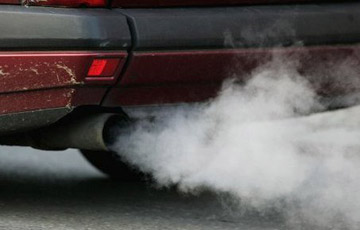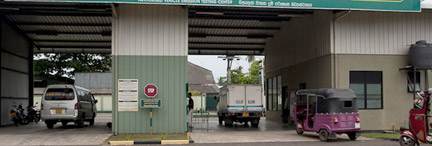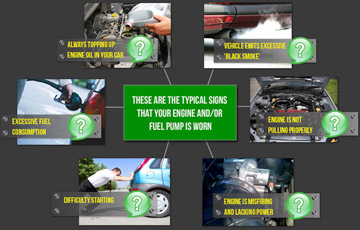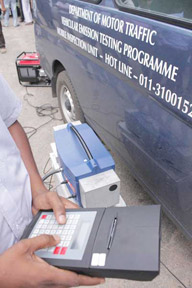DMT sets up vehicle emission testing raids
By Kurulu Kariyakarawana
Environmental pollution has become a serious concern world over an d
now Sri Lanka has entered the fray because of the vast number of
vehicles entering and exiting the city.

Commissioner General Department of Motor Traffic S H
Harishchandra |

Project Director VET A W Disanayake |
|

Carbon Monoxide being emitted- the cause of environmental
pollution |
Sri Lanka has about 5.1million registered vehicles running on the
roads at present. Out of this at least one million vehicles enter and
exit Colombo daily which is a staggering amount compared to the compact
routes and the proportion of the city. All these automobiles emit gases
of waste of fuel burn that involuntarily enter the atmosphere which
could be hazardous to the environment. This is why the Government
introduced a vehicle emission testing system in 2008 starting from the
Western Province that by now developed into a fully-fledged system
throughout the country.
Motorists had to subject their vehicles to an annual test and obtain
a certificate. However, the necessity to monitor the smooth flow of this
system was vital as instances of certain motorists producing false
certificates upon demand by the vehicle emission testing inspectors
lately has been observed.
The Department of Motor Traffic(DMT) and the Ministry of Environment
and Renewable Energy, the Central Environment Authority and the
Department of Measurement Units, Standard and Services have launched a
joint operation to conduct a countrywide inspection program on errant
motorists who possess false certificates obtained from shady vehicle
emission testing centres by soliciting financial bribes. Joint teams of
representatives of these institutes will apprehend drivers who do not
maintain vehicle standards.
Setting up vehicle emission testing laws was initiated by the
Ministry of Environment following a court order in 2000. This however
had to be re-gazetted in 2003 as the adapted international standards of
the emission testing system was too advanced for the non brand new and
vehicles in poor condition found on Sri Lankan roads. This came into
effect in 2008 by initialing the project in the Western Province on
November 18. It then took effect in Central, Southern and North Central
Provinces in June 2009. The program then operated in the Uva,
Sabaragamuwa and North Western Provinces. The Eastern Province in July
2011 and in the Northern Province in January 2013. Although the emission
testing systems were in place since 2008 the DMT could not implement the
law as the system was not installed in the North and the East until the
war on terrorism ended in 2009. Special instructions were given to
officials not to check vehicles registered in those provinces. Project
Director VET (Vehicle Emission Testing) and former Assistant
Commissioner of the Department of Motor Traffic A W Disanayake said that
the VET project was launched about one and a half years back and was in
operation. According to Dissanayake there are about 340 registered
vehicle emission testing centres operating countrywide. These centres
registered with the Department of Motor Traffic include mobile emission
testing facilities as well, where the testing centres are sent to rural
locations for the convenience of the public who may have to travel long
to find a centre. The motorists in the rural areas could gather to a mobile centre on a specific date announced previously.
 |
|
Emission Testing Centre |
The emission testing centres are approved by the DMT once they have
the correct gear and the specially trained staff to conduct the testing.
All these centres are connected to a main database in the DMT head
office where they get an alert from each and every testing being done in
any of the centre in any given area. This is a special feature where the
DMT could check the progress of an emission test as well the accuracy of such a
test.
The online data received from these centres could tell the details of
the centre, owner of the vehicle, the province in which the vehicle
registered under, the model of the vehicle as well as engine numbers and
chassis numbers.
 |
|
VET Poster |
It also has the ability to check the RPM and the temperature of a
vehicle that is being tested. Emission tests are being carried out under
the international standard of SAEG 1667 (Society of Automobile
Engineers).
The measurement used to measure the emission level is K-factor, which
should be below eight for a vehicle to pass the emission test. The
emission testing is done by sending a special light ray in to the
silencer of the vehicle and increase the RPM to the maximum level for
three seconds in which the amount of light rays are disturbed by the
exhausting emission is gauged. This is called the Absorption Coefficient
or the K-factor. If the K-factor is over eight the certain parts of the
vehicles should be repaired
to minimise the emission. Normally the emission levels of a vehicle
increases if the parts like Air Filter, Engine Oil Filter, Injector
Pumps are worn out. By replacing these parts the exhausting emission
levels can be reduced.
There are standard rates introduced by the DMT to charge from the
motorists to test their vehicles.
Motorcycles Rs.415,
Motor Tricycles Rs.505,
Motorcars Rs.1110,
Dual Purpose Vehicles Rs.1200,
Motor Lorries Rs.1560,
Motor Coaches Rs.1020,
Buses Rs.1010 and
Prime Movers Rs.1660.
All these prices are applied to all the approved vehicle emission
centres.
It is compulsory to get an annual emission test by all vehicle owners
according to the Sentence 29 of the Motor Traffic Act. The act enables
the officials to check the vehicles at any given time under the
sentences of 194, 198 of the Motor Traffic Act. Since the testing
facilities are fully functioning countrywide and access is available to
all vehicle users the DMT is to conduct more and more snap raids on the
roads to test the drivers who do not adhere to these laws. Commissioner
General Department of Motor
|

Mobile Emission Tracking System |
Traffic S H Harishchandra said the detecting teams are operating
daily to apprehend errant drivers. These teams select random areas a day
and conduct checking with state of the art equipment. The vehicles that
have excessive emission levels will be marked with their registration
numbers and be informed afterwards by post. They are given a
concessionary period to fix their engines and reduce the emission levels before imposing a fine.
Every motorist has to have a vehicle emission testing certificate
obtained by now and the annual emission testing record.
If a driver is found without the annual emission testing record he
will be subjected to a fine of Rs.3, 000 whereas if a vehicle is caught
without an emission testing certificate the owner would be imposed a
fine of Rs.20, 000 or a prison sentence.
According to the DMT Commissioner General these strict laws are not
pertaining only for the motorists but for the emission testing centres
as well. Since 2008 up to now over 300 centres had been dismissed by the
DMT for not maintaining the standards and also for issuing false
certificates and test reports for motorists for soliciting bribes.
Vehicle emission testing is an important feature not only as a gauge
of monitoring vehicles with fine condition enter into the roads but
concerning the atmosphere we live in. As vehicle emission releases
dangerous gases like Carbon Monoxide (CO), Hydrocarbon (HC), Sulphur
Dioxide (SO2) and Nitrogen Oxcide (NO2) which are hazardous for the
living beings, controlling them releasing to the atmosphere is not to
mention. |

